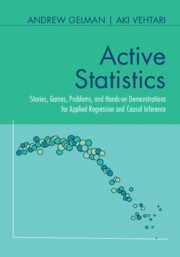Refine search
Actions for selected content:
52346 results in Statistics and Probability
Asymptotic results for sums and extremes
- Part of
-
- Journal:
- Journal of Applied Probability / Volume 61 / Issue 4 / December 2024
- Published online by Cambridge University Press:
- 13 March 2024, pp. 1153-1171
- Print publication:
- December 2024
-
- Article
- Export citation
Physics-informed neural networks for structural health monitoring: a case study for Kirchhoff–Love plates
- Part of
-
- Journal:
- Data-Centric Engineering / Volume 5 / 2024
- Published online by Cambridge University Press:
- 13 March 2024, e6
-
- Article
-
- You have access
- Open access
- HTML
- Export citation
Toward achieving smart cities in Africa: challenges to data use and the way forward
-
- Journal:
- Data & Policy / Volume 6 / 2024
- Published online by Cambridge University Press:
- 13 March 2024, e13
-
- Article
-
- You have access
- Open access
- HTML
- Export citation
Mobile data for studying public space, and trips in Mexico City: a study case of six suburban zones
-
- Journal:
- Data & Policy / Volume 6 / 2024
- Published online by Cambridge University Press:
- 12 March 2024, e14
-
- Article
-
- You have access
- Open access
- HTML
- Export citation
PDMP Monte Carlo methods for piecewise smooth densities
- Part of
-
- Journal:
- Advances in Applied Probability / Volume 56 / Issue 4 / December 2024
- Published online by Cambridge University Press:
- 12 March 2024, pp. 1153-1194
- Print publication:
- December 2024
-
- Article
- Export citation
Temporal trend analysis of acute hepatitis B virus infection in China, 1990–2019
-
- Journal:
- Epidemiology & Infection / Volume 152 / 2024
- Published online by Cambridge University Press:
- 12 March 2024, e48
-
- Article
-
- You have access
- Open access
- HTML
- Export citation
A generalized hypothesis test for community structure in networks
-
- Journal:
- Network Science / Volume 12 / Issue 2 / June 2024
- Published online by Cambridge University Press:
- 11 March 2024, pp. 122-138
-
- Article
-
- You have access
- Open access
- HTML
- Export citation
TB index case tracing in the Roma community in the Czech Republic
-
- Journal:
- Epidemiology & Infection / Volume 152 / 2024
- Published online by Cambridge University Press:
- 11 March 2024, e45
-
- Article
-
- You have access
- Open access
- HTML
- Export citation
Time series analysis of GSS bonds
-
- Journal:
- British Actuarial Journal / Volume 29 / 2024
- Published online by Cambridge University Press:
- 11 March 2024, e3
-
- Article
-
- You have access
- Open access
- HTML
- Export citation
SEMIPARAMETRIC ESTIMATION OF DYNAMIC BINARY CHOICE PANEL DATA MODELS
-
- Journal:
- Econometric Theory / Volume 41 / Issue 4 / August 2025
- Published online by Cambridge University Press:
- 11 March 2024, pp. 907-946
-
- Article
-
- You have access
- Open access
- Export citation
Color-avoiding percolation and branching processes
- Part of
-
- Journal:
- Journal of Applied Probability / Volume 61 / Issue 3 / September 2024
- Published online by Cambridge University Press:
- 08 March 2024, pp. 942-966
- Print publication:
- September 2024
-
- Article
- Export citation
Methodological moderators of average outdegree centrality: A meta-analysis of child and adolescent friendship networks
-
- Journal:
- Network Science / Volume 12 / Issue 2 / June 2024
- Published online by Cambridge University Press:
- 08 March 2024, pp. 107-121
-
- Article
-
- You have access
- Open access
- HTML
- Export citation

Active Statistics
- Stories, Games, Problems, and Hands-on Demonstrations for Applied Regression and Causal Inference
-
- Published online:
- 07 March 2024
- Print publication:
- 14 March 2024
Index
-
- Book:
- Polling at a Crossroads
- Published online:
- 29 February 2024
- Print publication:
- 07 March 2024, pp 267-269
-
- Chapter
- Export citation
Actuarial applications of natural language processing using transformers: Case studies for using text features in an actuarial context
-
- Journal:
- British Actuarial Journal / Volume 29 / 2024
- Published online by Cambridge University Press:
- 07 March 2024, e4
-
- Article
-
- You have access
- Open access
- HTML
- Export citation
Multitask feature selection within structural datasets
-
- Journal:
- Data-Centric Engineering / Volume 5 / 2024
- Published online by Cambridge University Press:
- 07 March 2024, e4
-
- Article
-
- You have access
- Open access
- HTML
- Export citation
R-positivity and existence of zero-temperature limits of Gibbs measures on nearest neighbors matrices – CORRIGENDUM
-
- Journal:
- Journal of Applied Probability / Volume 61 / Issue 2 / June 2024
- Published online by Cambridge University Press:
- 07 March 2024, p. 739
- Print publication:
- June 2024
-
- Article
-
- You have access
- HTML
- Export citation
2 - The Story of Polling in 21/2 Fiascos
- from Part I - Polling in Context
-
- Book:
- Polling at a Crossroads
- Published online:
- 29 February 2024
- Print publication:
- 07 March 2024, pp 23-46
-
- Chapter
- Export citation
9 - Next-Generation Selection Models
- from Part III - Fighting Nonignorable Nonresponse
-
- Book:
- Polling at a Crossroads
- Published online:
- 29 February 2024
- Print publication:
- 07 March 2024, pp 165-182
-
- Chapter
- Export citation
Contents
-
- Book:
- Polling at a Crossroads
- Published online:
- 29 February 2024
- Print publication:
- 07 March 2024, pp vii-x
-
- Chapter
- Export citation
